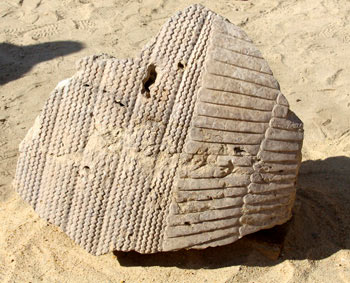Missing Pieces from Statue of King Tut's Grandparents Found

Six missing pieces from a colossal double statue of King Tut's grandparents have been discovered at a temple on the west bank of the Nile in Luxor, Egypt's minister of culture, Farouk Hosny, announced Tuesday (Jan. 11).
The more than 3,000-year-old statue depicts Tut's grandfather King Amenhotep III and his wife Queen Tiye. The ninth ruler of the 18th Dynasty, Amenhotep III (about 1390-1352 B.C.), reigned for about 39 years during a time when Egypt was at the height of prosperity and cultural development.
The double statue was first discovered in 1889 at the Medinet Habu, an area in Luxor and a mortuary temple. At the time, an Italian team restored the statue and filled in the missing pieces with modern stonework.
Wig, arm and foot fragments
The recent recovery of the missing pieces that belonged to Amenhotep III included fragments from the right side of his chest, nemes headdress (a striped head cloth that pharaohs of ancient Egypt wore) and leg. The pieces of Queen Tiye that were uncovered included a section of her wig, and pieces from her left arm, fingers and foot. [Image of wig fragment and fingers]
The Egyptian team also found a small section of the base of the double statue. These pieces are currently being held at the site of Medinet Habu, in one of the side courts, but they will soon be relocated to the Egyptian Museum in Cairo for restoration and placement into the colossal statue.
Abdel Ghaffar Wagdy, the supervisor of the excavation at the site in Luxor, said that the pieces of statuary were found as part of a project to lower the groundwater on the west bank of Luxor.
Sign up for the Live Science daily newsletter now
Get the world’s most fascinating discoveries delivered straight to your inbox.
King Tut mysteries
The finding adds to work to pin down the family tree of King Tutankhamun, Egypt's boy king, who ruled from 1333 B.C. to 1324 B.C., during the period of ancient Egyptian history known as the New Kingdom. Though he is possibly the most well-known of the Egyptian pharaohs, many mysteries still exist about the life, death and parentage of King Tut.
Egyptologists are hard at work to pin down King Tut's family tree. Candidates for King Tut's mother and father were recently identified using DNA analyses from royal Egyptian mummies.
Archaeologist Zahi Hawass of the Supreme Council of Antiquities and his colleagues analyzed the DNA of 11 royal mummies of the New Kingdom, both to search for any signs of genetic disorders that could have killed Tut, as well as to establish familial relationships between them.
In addition to Tutankhamun, 10 mummies (circa 1410-1324 B.C.) believed related in some way to Tutankhamun were chosen as part of the family-tree study; of these, the identities were certain for only three. In addition to these 11 mummies, five other royal individuals dating to the early New Kingdom (circa 1550-1479 B.C.) were selected because they were distinct from the supposed members of the Tutankhamun lineage — a sort of mummy control group.
Genetic fingerprinting allowed the construction of a five-generation pedigree of Tutankhamun's immediate lineage.
The researchers were able to definitively identify several of the anonymous mummies or those whose identities were believed known, including Tiye, mother of the pharaoh Akhenaten and grandmother of Tutankhamun. Another mummy is thought to be Akhenaten, father of Tutankhamun.
- Images: Amazing Egyptian Discoveries
- Image Gallery: The Seven Ancient Wonders of the World
- History's Most Overlooked Mysteries
You can follow LiveScience Managing Editor Jeanna Bryner on Twitter @jeannabryner.











